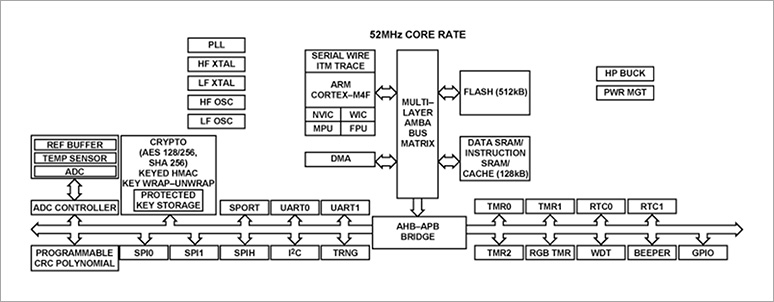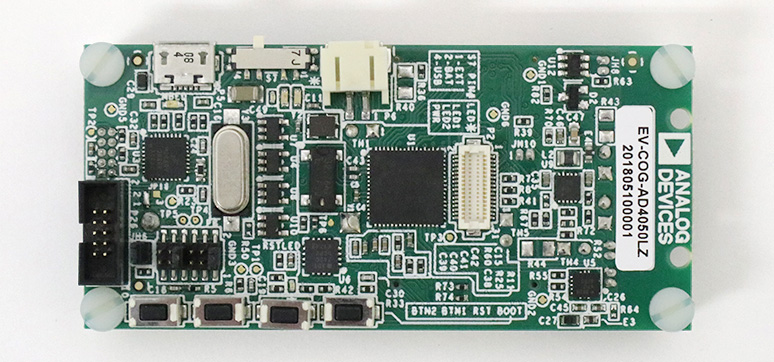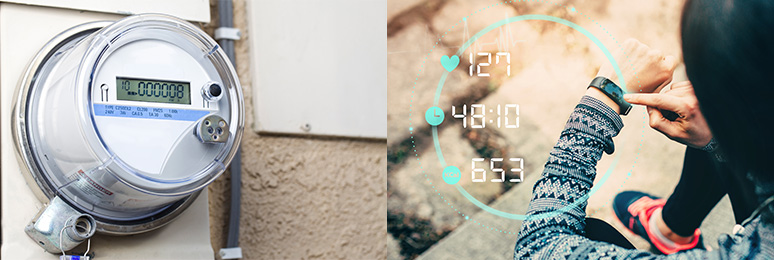Achieves 1/10th the power consumption at the system level
"ADuCM4050" is an ultra-low power consumption microcontroller provided by Analog Devices.
Equipped with Arm® Cortex®-M4, it can achieve low power consumption and advanced calculation processing. Equipped with large capacity 128KB SRAM and 512KB embedded flash memory, it is possible to reduce the amount of data sent to the host side by performing signal processing on the sensor node side.
In addition, the ADuCM4050's SensorStrobe technology allows it to maintain a low power mode while collecting sensor data and performing RF communications. Therefore, power consumption at the system level can be significantly reduced.
The ADuCM4050 has four major features:
- Protect IoT device data with strong encryption
- Ultra-low power consumption greatly contributes to longer operating life and longer charging intervals
- Easy sensor connection with digital/analog interface
- SensorStrobe technology for system-level power reduction
The features of each are explained below.
1. Protect IoT device data with strong encryption
In IoT applications, it is common to collect data from numerous sensors and transfer the data to the host side using RF communication. Therefore, countermeasures against information leaks are extremely important.
The ADuCM4050 supports modes such as Electronic Codebook (ECB), Cryptographic Blockchain (CBC), and Counter (CTR), as well as advanced encryption standards AES-128 and AES-256 with secure hashing algorithm SHA-256. Equipped with encryption hardware.
Collected data in IoT applications can be safely protected.
2. Ultra-low power consumption greatly contributes to longer operating life and longer charging intervals
The ADuCM4050 features multiple power modes for ultralow power consumption. It operates at 41µA/MHz in active mode and drops to 650nA in hibernate mode. Data in SRAM and flash memory can be retained even in hibernate mode.
Therefore, data can be retrieved quickly when waking up from hibernation (sleep) mode, and power consumption can be reduced.
| action mode | power consumption |
| Active | 41uA/MHz |
| in hibernation mode | 650nA (typ) |
| Shutdown mode | 50 nA (typ) |
| Fast wakeup | 200 nA (typ) |
3. Easy sensor connection with digital/analog interface
The ADuCM4050 includes common digital interfaces SPI, I2C, and UART, as well as analog subsystems such as an analog-to-digital converter (ADC) as well as clocking, reset, and power management functions.
A single chip can provide the sensing and measurement functions required for IoT applications.

4. SensorStrobe technology for system level power reduction
The ADuCM4050 includes a unique SensorStrobe mechanism. Typical IoT applications using microcontrollers use GPIO in software to generate pulses, trigger sensors at specific intervals, and collect data. As a result, typical microcontrollers incur a significant amount of software overhead and consume power.
SensorStrobe technology is a function that sends the trigger pulse necessary for data collection at the sensor while the CPU core is stopped. With this function, it is possible to start the CPU after data is accumulated on the sensor side, and perform operations such as data reception and data processing. The synergistic effect of superior processing performance and SensorStrobe functionality enables system-level power savings by minimizing time in active mode and extending periods in hibernation mode.
Development kit for developing the ADuCM4050
Analog Devices, Inc. provides the development kit "EV-COG-AD4050" to easily develop the ADuCM4050.

The following development environment is required to use the EV-COG-AD4050 board.
- Crosscore Embedded Studio 2.7.0 or later - Eclipse-based development environment
- IAR Embedded Workbench for ARM 8.20 or higher
- Keil uVision 4 or higher
- ARM mbed compiler
Click here for hardware details.
EV-COG-AD4050LZ MCU Cog [Analog Devices Wiki]
You can start evaluating this evaluation board immediately by following the steps below.
1. Set up your development environment
Install and set up IAR Embedded Workbench for ARM on your development PC.
- IAR Embedded Workbench for ARM (version 8.20.1 or higher)
Download and install the following drivers for EV-COG-AD4050.
- ARM CMSIS Pack Analog Devices ADuCM4050 Device Family Pack (DFP)
- Analog Devices EV-COG-AD4050 Board Support Package (BSP) / Off-chip drivers and samples
2. Launch IAR Embedded Workbench
Start IAR Embedded Workbench for ARM and load the software downloaded in [1.].
3. Run the sample project and start evaluation
Create a new project in IAR IDE and specify the sample program.
After compiling and building the project, download it to the evaluation board using CMSIS-DAP.
You can start the sample program by clicking the "Run" icon.
By following the steps above, you can immediately check the operation using the sample program.
Application example
- IoT equipment
- smart machine
- smart building
- smart metering
- Smart farms, sensor networks
- wearable device
- Vital sign monitoring/biological information
- fitness, medical

Product Summary
| Type name | ADuCM4050 |
| specification |
|
Click here to purchase products
Click here for manufacturer site/other related links
Inquiry
If you have any questions regarding this article, please contact us below.
Analog Devices Manufacturer Information Top
If you want to return to Analog Devices Manufacturer Information Top, please click the button below.
